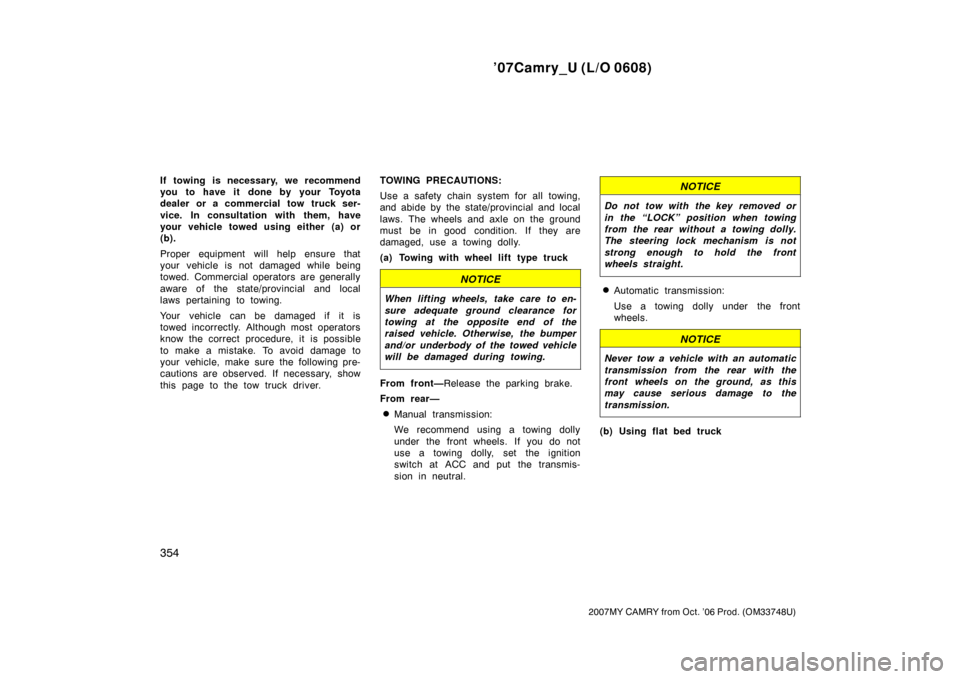Page 362 of 428

’07Camry_U (L/O 0608)
354
2007MY CAMRY from Oct. ’06 Prod. (OM33748U)
If towing is necessary, we recommend
you to have it done by your Toyota
dealer or a commercial tow truck ser-
vice. In consultation with them, have
your vehicle towed using either (a) or
(b).
Proper equipment will help ensure that
your vehicle is not damaged while being
towed. Commercial operators are generally
aware of the state/provincial and local
laws pertaining to towing.
Your vehicle can be damaged if it is
towed incorrectly. Although most operators
know the correct procedure, it is possible
to make a mistake. To avoid damage to
your vehicle, make sure the following pre-
cautions are observed. If necessary, show
this page to the tow truck driver.TOWING PRECAUTIONS:
Use a safety chain system for all towing,
and abide by the state/provincial and local
laws. The wheels and axle on the ground
must be in good condition. If they are
damaged, use a towing dolly.
(a) Towing with wheel lift type truck
NOTICE
When lifting wheels, take care to en-
sure adequate ground clearance for
towing at the opposite end of the
raised vehicle. Otherwise, the bumper
and/or underbody of the towed vehicle
will be damaged during towing.
From front—Release the parking brake.
From rear—
�Manual transmission:
We recommend using a towing dolly
under the front wheels. If you do not
use a towing dolly, set the ignition
switch at ACC and put the transmis-
sion in neutral.
NOTICE
Do not tow with the key removed or
in the “LOCK” position when towing
from the rear without a towing dolly.
The steering lock mechanism is not
strong enough to hold the front
wheels straight.
�Automatic transmission:
Use a towing dolly under the front
wheels.
NOTICE
Never tow a vehicle with an automatic
transmission from the rear with the
front wheels on the ground, as this
may cause serious damage to the
transmission.
(b) Using flat bed truck
Page 377 of 428

’07Camry_U (L/O 0608)
369
2007MY CAMRY from Oct. ’06 Prod. (OM33748U)
Automatic transmission “Park” mecha-
nism
Check the lock release button of the se-
lector lever for proper and smooth opera-
tion. On a safe incline, check that your
vehicle is held securely with the selector
lever in “P” position and all brakes re-
leased.
OUTSIDE THE VEHICLE
Items listed below should be performed
from time to time, unless otherwise
specified.
Fluid leaks
Check underneath for leaking fuel, oil, wa-
ter or other fluid after the vehicle has
been parked for a while. If you smell fuel
fumes or notice any leak, have the cause
found and corrected immediately.
Doors and engine hood
Check that all doors including trunk lid
operate smoothly and all latches lock se-
curely. Make sure the engine hood sec-
ondary latch secures the hood from open-
ing when the primary latch is released.Tire inflation pressure
Check the pressure with a gauge ev-
ery two weeks, or at least once a
month. See page 385 in Section 7−2
for additional information.
Tire surface and wheel nuts
Check the tires carefully for cuts,
damage or excessive wear. See page
388 in Section 7−2 for additional in-
formation. When checking the tires,
make sure no nuts are missing, and
check the nuts for looseness. Tighten
them if necessary.
Tire rotation
Rotate the tires according to the
maintenance schedule. (For sched-
uled maintenance information, please
refer to the “Scheduled Maintenance
Guide” or “Owner ’s Manual Supple-
ment”.) See page 390 in Section 7−2
for additional information.Be on the alert for changes in perfor-
mance, sounds, and visual tip−offs that
indicate service is needed. Some impor-
tant clues are as follows:
�Engine missing, stumbling, or pinging
�Appreciable loss of power
�Strange engine noises
�A leak under the vehicle (however, wa-
ter dripping from the air conditioning
after use is normal.)
�Change in exhaust sound (This may
indicate a dangerous carbon monoxide
leak. Drive with the windows open and
have the exhaust system checked im-
mediately.)
�Flat−looking tire; excessive tire squeal
when cornering; uneven tire wear
�Vehicle pulls to one side when driving
straight on a level road
�Strange noises related to suspension
movement
�Loss of brake effectiveness; spongy
feeling brake or clutch pedal; pedal al-
most touches floor; vehicle pulls to one
side when braking
�Engine coolant temperature continually
higher than normal
Does your vehicle need
repairing?
Page 385 of 428
![TOYOTA CAMRY 2007 XV40 / 8.G Owners Manual ’07Camry_U (L/O 0608)
377
2007MY CAMRY from Oct. ’06 Prod. (OM33748U)
Rear (3.5 L V6 [2GR�FE] engine)
When jacking up your vehicle with the
jack, position the jack correctly as
shown in the illust TOYOTA CAMRY 2007 XV40 / 8.G Owners Manual ’07Camry_U (L/O 0608)
377
2007MY CAMRY from Oct. ’06 Prod. (OM33748U)
Rear (3.5 L V6 [2GR�FE] engine)
When jacking up your vehicle with the
jack, position the jack correctly as
shown in the illust](/manual-img/14/6217/w960_6217-384.png)
’07Camry_U (L/O 0608)
377
2007MY CAMRY from Oct. ’06 Prod. (OM33748U)
Rear (3.5 L V6 [2GR�FE] engine)
When jacking up your vehicle with the
jack, position the jack correctly as
shown in the illustrations.
CAUTION
When jacking, be sure to observe the
following to reduce the possibility of
death or serious injury:
�Follow jacking instructions.
�Do not put any part of your body
under the vehicle supported by the
jack. Personal injury may occur.
�Do not start or run the engine while
your vehicle is supported by the
jack.
�Stop the vehicle on a level firm
ground, firmly set the parking brake
and put the transmission in “P”
(automatic) or reverse (manual).
Block the wheels on the opposite
side of the jack up point if neces-
sary.
�Make sure to set the jack properly
in the jack point. Raising the ve-
hicle with jack improperly posi-
tioned will damage the vehicle or
may allow the vehicle to fall off the
jack and cause personal injury.
�Never get under the vehicle when
the vehicle is supported by the jack
alone; use vehicle support stands.
�Do not raise the vehicle with some-
one in the vehicle.
�When raising the vehicle, do not
place any objects on top of or un-
derneath the jack.
NOTICE
Make sure to place the jack correctly,
or your vehicle may be damaged.
Page 417 of 428

’07Camry_U (L/O 0608)
409
2007MY CAMRY from Oct. ’06 Prod. (OM33748U)
BATTERY
Open voltage
∗ at 20�C (68�F):
12.6—12.8 V Fully charged
12.2—12.4 V Half charged
11.8—12.0 V Discharged
∗: Voltage that is checked 20 minutes af-
ter the key is removed with all the lights
turned off
Charging rates:
5 A max.
Note: If replacement is necessary, make
sure to do so with a battery that meets
the same standard as the original.
CLUTCH
Pedal free play, mm (in.):
5—15 (0.2—0.6)
Fluid type:
SAE J1703 or FMVSS No.116 DOT 3
MANUAL TRANSAXLE
Oil capacity, L (qt., Imp. qt.):
2.5 (2.6, 2.2)
Oil type:
Gear oil API GL−4 or GL−5
Recommended oil viscosity:
SAE 75W−90AUTOMATIC TRANSAXLE
Fluid capacity (drain and refill), L (qt.,
Imp. qt.):
2.4 L 4−cylinder (2AZ−FE) engine
3.5 (3.7, 3.1)
3.5 L V6 (2GR−FE) engine
6.57 (6.94, 5.78)∗
∗
: The fluid capacity is the quantity of
reference. If replacement is necessary,
contact your Toyota dealer.
Fluid type:
Toyota Genuine ATF WS
Change automatic transmission fluid only
as necessary.
Generally, it is necessary to change
automatic transmission fluid only if your
vehicle is driven under one of the Special
Operating Conditions listed in your
“Scheduled Maintenance Guide” or
“Owner ’s Manual Supplement”. When
changing the automatic transmission fluid,
use only “Toyota Genuine ATF WS” (ATF
JWS3324 or NWS9638) to aid in assuring
optimum transaxle performance.Notice: Using automatic transmission
fluid other than “Toyota Genuine ATF
WS” may cause deterioration in shift
quality, locking up of your transmission
accompanied by vibration, and ultimate-
ly damage the automatic transmission
of your vehicle.
Please contact your Toyota dealer for fur-
ther details.
Page 418 of 428
’07Camry_U (L/O 0608)
410
2007MY CAMRY from Oct. ’06 Prod. (OM33748U)
BRAKES
Minimum pedal clearance when depressed
with the force of 500 N (51 kgf, 112 lbf)
with the engine running, mm (in.):
Manual transmission models
63 (2.5)
Automatic transmission models
61 (2.4)
Pedal free play, mm (in.):
1—6 (0.04—0.24)
Pad wear limit, mm (in.):
1.0 (0.04)
Parking brake
Lever type—
Parking brake adjustment when pulled
with the force of 200 N (20 kgf, 44
lbf):
7—9 clicks
Pedal type—
Parking brake adjustment when de-
pressed with the force of 300 N (31
kgf, 67 lbf):
7—10 clicks
Fluid type:
SAE J1703 or FMVSS No.116 DOT 3STEERING
Wheel free play:
Less than 30 mm (1.2 in.)
Power steering fluid type:
Automatic transmission fluid DEXRON�II
or III
Page:
< prev 1-8 9-16 17-24